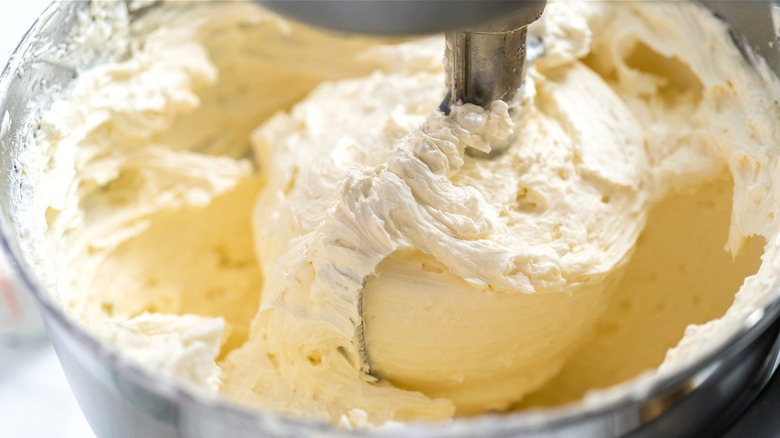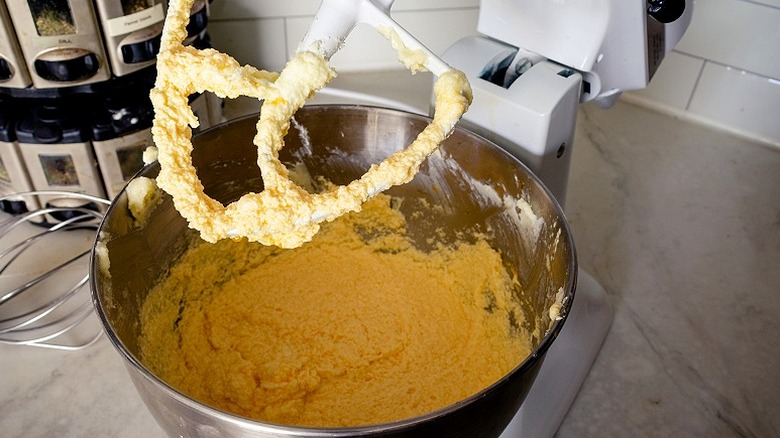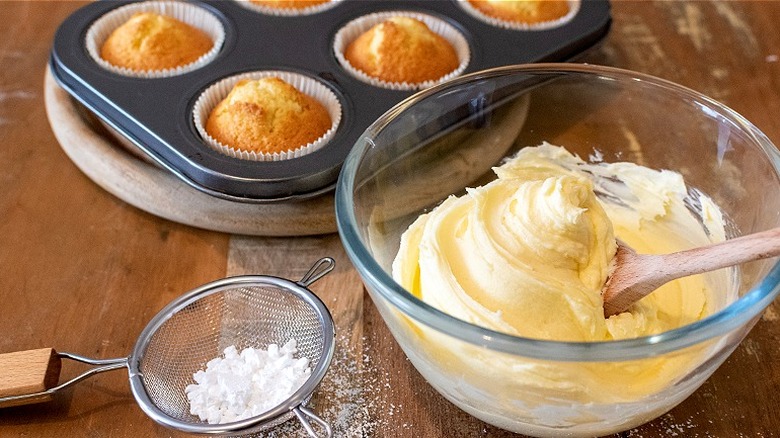The Easy Heat Trick That's Sure To Fix Your Broken Buttercream
For those of us with an unrelenting sweet tooth, nothing beats the epic combination of homemade layer cake paired with traditional American buttercream frosting. Buttercream may seem simple enough to make considering the standard recipe calls for a small handful of ingredients: butter, powdered sugar, milk or cream, and vanilla. However, timing proves to be everything when it comes to this creamy confection.
Out of all the useful tips to follow when making your own buttercream frosting at home, using room-temperature butter is key in crafting a perfectly smooth frosting. Precisely speaking, room temperature butter should read between 65 to 67 degrees when inserted with a thermometer, but this ideal temperature is achieved easily by making sure you leave your butter out of the refrigerator to soften for at least 30 minutes before whipping with powdered sugar and milk. If you're in a rush and happen to use butter before it has softened to the ideal temperature, your resulting frosting can have significant lumps leaving you with an occasional mouthful of hard creamy fat, commonly known as broken buttercream. Fortunately, you can fix your buttercream woes with a small amount of warmth, and one convenient tool you may consider using just so happens to live in your bathroom closet.
Fix your lumpy buttercream with a little heat
While the fastest way to achieve room-temperature butter happens to include a rolling pin, there are some easy heat sources that can fix broken buttercream. First, to clarify, if your buttercream doesn't have a smooth texture, it's most likely due to the cold temperature of your butter and its inability to break down when mixed with milk and powdered sugar. You can also get grainy buttercream if you don't sift your powdered sugar before mixing.
If you've realized the butter is where your problems lie, all you need to fix these pesky lumps is a small amount of heat. The easiest way to do this is by warming the base of your mixing bowl with your hands, a hot towel, or a larger bowl with a small amount of warm water for your mixing bowl to sit inside. This heating trick almost mirrors the double boiler method for melting chocolate but without the use of scalding hot water. Another convenient way of smoothing out these buttery lumps is through the intermittent use of a hair dryer along the bottom of your mixing bowl. Whichever warming method you decide to use to soften these small chunks of butter, just make sure you use them sparingly so you don't accidentally melt your buttercream in the process. As a matter of fact, in shining a light on the opposite problem, what can you do to fix buttercream that's become too runny?
How to fix liquified buttercream
Conversely, if you happen to mix your frosting only to find its consistency much too thin for those perfect vanilla cupcakes with American buttercream, there are some ways you can try firming up this confection. First off, you should avoid adding too much liquid to your frosting. Adding extra ingredients that have a liquid component such as jam or liquid sweetener can leave you with thin frosting. When following directions for your next batch of buttercream, only add a small amount of the suggested cream or milk at a time so you can check the consistency continually. If you happen to add too much milk, you can always add more powdered sugar, but keep in mind that too much may leave you with a frosting that's too sweet. You are also running the risk of overmixing your frosting by having to add even more powdered sugar at the end which can only lead to more separation.
The other reason your buttercream may appear too thin could also be a temperature issue. Unlike lumpy frosting that's too cold, runny frosting may have become too warm resulting in butter that's accidentally melted in the mixing process. To fix this, simply freeze your buttercream in small increments to check if the butter has firmed up enough to hold its shape. With just a few temperature adjustments, most buttercream recipes can eventually form an ideal consistency — just make sure you don't overmix the ingredients.


